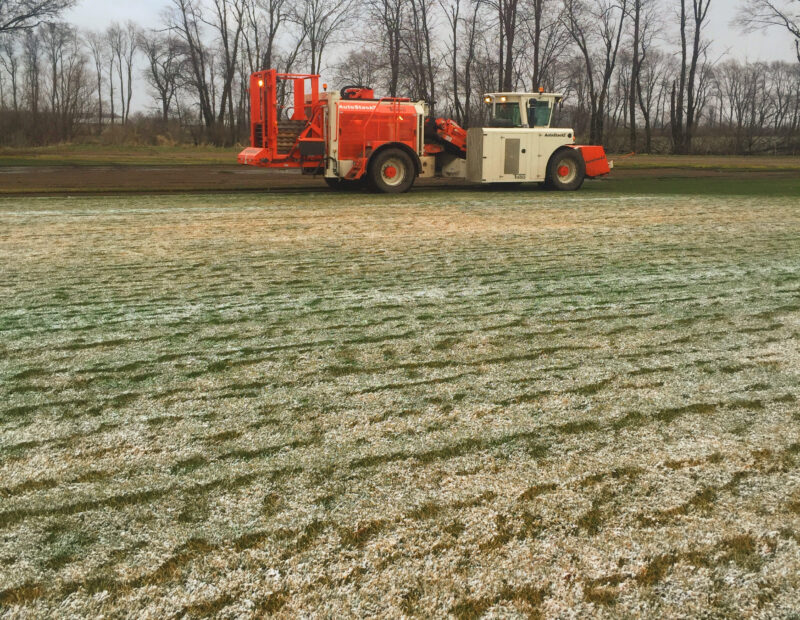Sometimes, grass in shade will last a few years and then die, requiring reseeding. That may be the best you can do. If you want to be a millionaire, invent a grass that holds up in shade. To be a multimillionaire, invent one that also withstands dog traffic in shade!
Certain ornamentals like hostas or impatient flowers need shade to look their best, but no grass likes shade. As a result, everyone trying to maintain good quality grass in shady areas is fighting an uphill battle. Sometimes, grass can be improved in shade if you understand the problems grass faces.
There are two problems grass faces in shade. First is the lack of quantity and quality of sunlight. If the grass is under trees or an overhang, there is simply less light striking it. If the light is reflected or filtered, the quality of light is diminished. Grass plants respond by producing long spindly leaves. These leaves are not as hardy as leaves grown in direct sunlight and are more easily damaged and breached by leaf diseases. Less sunlight for the leaves also means a weaker root system because there are fewer carbohydrates available. The root system is shallower and less able to recuperate from wear. This is doubly bad when dogs are confined in a small area under a tree. The grass soon disappears due to increased wear and decreased ability to grow.
The second problem for grass in shade is reduced air movement. At night, dew settles on the grass. If the dew stays on the grass into mid-day, this extends the length of time the leaf blades are wet. Foliar diseases need “free water” like dew to spread. Long periods of wet leaves are perfect for disease development. Wise people who want to minimize disease development do what they can to shorten the amount of time the leaves are wet by not watering in the late afternoon or evening. The grass plant has extra disease pressure and is weakened by reduced light levels – no wonder it has a tough time surviving!
No Grass Likes Shade
Sometimes, grass in shade will last a few years and then die, requiring reseeding. That may be the best you can do. If you want to be a millionaire, invent a grass that holds up in shade. To be a multimillionaire, invent one that also withstands dog traffic in shade!
Certain ornamentals like hostas or impatient flowers need shade to look their best, but no grass likes shade. As a result, everyone trying to maintain good quality grass in shady areas is fighting an uphill battle. Sometimes, grass can be improved in shade if you understand the problems grass faces.
There are two problems grass faces in shade. First is the lack of quantity and quality of sunlight. If the grass is under trees or an overhang, there is simply less light striking it. If the light is reflected or filtered, the quality of light is diminished. Grass plants respond by producing long spindly leaves. These leaves are not as hardy as leaves grown in direct sunlight and are more easily damaged and breached by leaf diseases. Less sunlight for the leaves also means a weaker root system because there are fewer carbohydrates available. The root system is shallower and less able to recuperate from wear. This is doubly bad when dogs are confined in a small area under a tree. The grass soon disappears due to increased wear and decreased ability to grow.
The second problem for grass in shade is reduced air movement. At night, dew settles on the grass. If the dew stays on the grass into mid-day, this extends the length of time the leaf blades are wet. Foliar diseases need “free water” like dew to spread. Long periods of wet leaves are perfect for disease development. Wise people who want to minimize disease development do what they can to shorten the amount of time the leaves are wet by not watering in the late afternoon or evening. The grass plant has extra disease pressure and is weakened by reduced light levels – no wonder it has a tough time surviving!
No Grass Likes Shade

Updated 12/5/25
Red Hen Turf Farm’s
2025 Sod Harvesting Season
has OFFICIALLY ENDED
as of 12/5/25
due to SNOW / Precipitation and Unfavorable Field Conditions.
We had hoped to keep going until 12/19/25, but Mother Nature did not get that Memo, apparently :)
* * *
If you’re reading this in early 2026 and wonder when we might start back up again, a quick call will confirm our
SOD HARVEST FORECAST
– 574-232-6811 –
is the number to call.